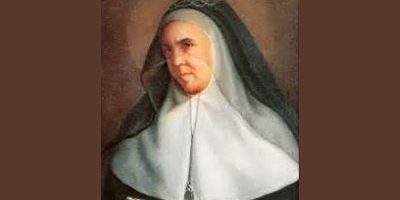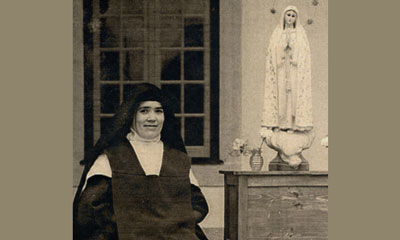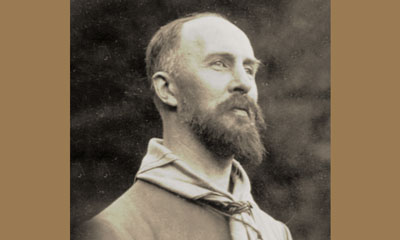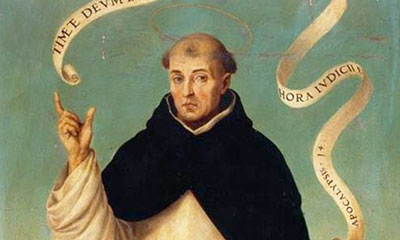March 25, 2018
Saint Emilie de Rodat
Dear Friends,
At certain moments in her life, Saint Émilie de Rodat greatly feared death, but in her final days, all fear disappeared. She nevertheless told her confessor: “Oh, my Father, go tell the worldly people who do not think of their final moments, that one does not learn to die in two days.” In his Rule, Saint Benedict had already emphasized how important it is to use our time well, thinking of our eternal salvation: “While there is still time, while we are still in the body and are able to fulfill all these things by the light of this life, we must hasten to do now what will profit us for eternity” (Prologue). Saint Émilie could rejoice at having spent her time in the service of the Lord.
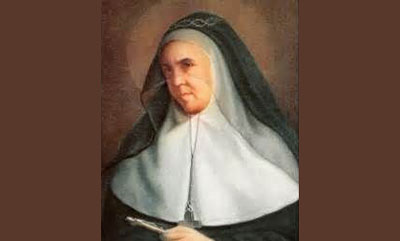 Émilie de Rodat was born in 1787 in Druelle Castle, not far from Rodez (south of France), into a solidly Christian family in which everyone devoted themselves to the duties of their state, generously accomplished with divine support. To lighten Madame de Rodat’s load, Émilie was sent to live with her grandmother, in Villefranche-de-Rouergue. One of her aunts, a Visitandine nun, also lived there, having retired to her mother’s home. There, the child received a serious upbringing and learned to love the poor, to whom she loved to give alms. “As a very young girl,” Émilie would later write in her autobiography, “I had the fault of pouting. I would go to hide in a window recess. Then my grandmother would say to me: ‘…Look at me, you need to laugh!’ … and she would persist until I was cheered up… I was a whimperer. She gently worked to correct me of this fault, and made me confess it, which was quite difficult for me.” At the age of eleven, she made her first Communion: “I could not bring great preparation to this act, because of the unfortunate situation of the times,” she acknowledged, “but I brought innocence… I say this so that scrupulous people do not think all is lost when a child is still childish at the time of her first Communion. If the child is innocent, God Himself will come and live and act in her heart, as He did with me. He took hold of all the faculties of my soul and I felt myself immediately drawn to the holy practice of mental prayer. God Himself did it in me.”
Émilie de Rodat was born in 1787 in Druelle Castle, not far from Rodez (south of France), into a solidly Christian family in which everyone devoted themselves to the duties of their state, generously accomplished with divine support. To lighten Madame de Rodat’s load, Émilie was sent to live with her grandmother, in Villefranche-de-Rouergue. One of her aunts, a Visitandine nun, also lived there, having retired to her mother’s home. There, the child received a serious upbringing and learned to love the poor, to whom she loved to give alms. “As a very young girl,” Émilie would later write in her autobiography, “I had the fault of pouting. I would go to hide in a window recess. Then my grandmother would say to me: ‘…Look at me, you need to laugh!’ … and she would persist until I was cheered up… I was a whimperer. She gently worked to correct me of this fault, and made me confess it, which was quite difficult for me.” At the age of eleven, she made her first Communion: “I could not bring great preparation to this act, because of the unfortunate situation of the times,” she acknowledged, “but I brought innocence… I say this so that scrupulous people do not think all is lost when a child is still childish at the time of her first Communion. If the child is innocent, God Himself will come and live and act in her heart, as He did with me. He took hold of all the faculties of my soul and I felt myself immediately drawn to the holy practice of mental prayer. God Himself did it in me.”
However, during her adolescence, Émilie abandoned prayer, and allowed herself to be carried away by the world. She reveled in finery, and spent a great deal of time in front of the mirror. One day, a servant told her with a most direct outspokenness: “You might well look at yourself Mademoiselle—you’ll never be anything more than a sack of earth!” In 1803, her grandmother retired to the home of Madame de Saint-Cyr, where several nuns who had been forced to leave their convents at the time of the Revolution were living. She sent Émilie back to Druelle. The following year, the girl received the grace of a sudden light that invaded her soul: “I was so penetrated by God,” she would later say, “that I was continually in His presence, especially at church. There, His presence consumed me to the point that I neither saw nor heard what was happening around me.” From then on, she went to Mass every morning, and began to visit the poor, for whom she prepared jams and other sweets, visiting slums and humble dwellings, and even went so far as to care for a leper. After a year and a half, Émilie joined her grandmother and aunt in the home of Madame de Saint-Cyr. Father Marty, the chaplain of the house, encouraged her in prayer, gave her a taste for the Psalms, which she learned by heart, and strengthened her in her efforts toward renunciation and a life of poverty. Émilie became acquainted with the writings of Saint Francis de Sales. Soon, the young woman was asked to prepare children for first Communion, then to teach geography and other subjects. Her teaching was clear and lively; she fascinated her young audience.
Émilie often prayed to her guardian angel, and attributed to him a special protection during a grave and imminent danger: “I was going into the cellar,” she related, “and was loaded up with bottles. We were going down through a trap door. I thought it was closed but it was open. I stepped forward and the floorboard disappeared under my feet, I was about to fall, bottles in my hand, but I felt someone take me around the waist and hold me back. I thought immediately to thank my good Angel. Everyone in the house came running, believing that I had fallen into the cellar. I reassured them by recounting what had happened to me.”
In the fourth century, Saint Basil affirmed, “Beside each believer stands an angel as protector and shepherd leading him to [eternal] life.” (cf. Catechism of the Catholic Church, no. 336).
Three setbacks
During gatherings with family or friends, Émilie met young men who aroused her interest, but circumstances never allowed for the relationship to deepen. From then on, she led a poor and austere life; her confessor permitted her to make private vows. She was criticized for being more serious than cheerful, so she made efforts to appear more joyful, and read a treatise on joy. Father Marty encouraged her to temper her desire for meditation and speak more to others. Émilie considered entering the Sisters of Charity of Nevers, who ran the hospital in Figeac. She went there in 1809. “Scarcely had I entered this house,” she wrote, “than the Good Lord withdrew His perceptible presence. Deep shadows filled my soul. I did not know what to become. I saw failures in my entire life… I left this house after a month, forced by this interior distress.” She then turned to the “Ladies of Perpetual Adoration of Picpus,” in Cahors. But the chaplain of the house quickly discerned that while her vocation was very real, it was not for Picpus. Not discouraged, Émilie then made an attempt with the Sisters of Mercy in Moissac. Once again, she found herself plunged into darkness. She wished to persevere, but the superior would not keep her. These dead-end attempts brought her many humiliations. But she was not capricious or unstable, and knew she must bring real tenacity to fulfilling the divine will. Furthermore, she had done nothing without the advice of her director and of wise people. She resumed instructing young people in Madame de Saint-Cyr’s home, and visiting the sick.
One day in May 1815, she met some women complaining about how their school-age daughters had been abandoned. “Before the Revolution,” they explained to her, “the Ursulines taught for free; we ourselves had the good fortune to be taught by them.” Émilie asked Madame de Saint-Cyr for permission to bring poor girls into her little room to instruct them. Father Marty approved of this plan, and even pointed out three young women who might help her. From then on, they gathered each day to recite the Little Office of the Blessed Virgin Mary and other prayers. They nevertheless feared that their work might be detrimental to that of Madame de Saint-Cyr. But, with total selflessness, Madame de Saint-Cyr approved and encouraged their initiative. On the other hand, other individuals, even pious ones, engaged in snide remarks about Émilie and her companions. What is more, the young women’s families refused to approve. They described as “imprudence” the new foundation launched by inexperienced young women, and led by one who until that point had been unable to settle down anywhere. With the exception of Monsieur Marty, the clergy of Villefranche shared the general disapproval. Soon, however, they had to find a larger home than Émilie’s room. A space, inconvenient but sufficient, was rented. They moved in on April 30, 1816, with some borrowed beds and a bit of meager furniture, and the young teachers adopted uniform dress. Outside of class time, silence was kept in the house. Soon there were thirty students, plus an orphan girl who would become a boarder. Émilie gave her her bed and slept on a straw mattress on the ground. Alms in kind, which came mostly from the poor, allowed the work to continue. Touched by the goodwill of the burgeoning community, the bishop permitted them to keep the Blessed Sacrament in the house. The sisters considered Jesus in the Eucharist as their greatest treasure.
On March 25, 1996, in the apostolic exhortation Vita Consecrata, Saint John Paul II wrote, “those who are called to the consecrated life have a special experience of the light which shines forth from the Incarnate Word. For the profession of the evangelical counsels makes them a kind of sign and prophetic statement for the community of the brethren and for the world; consequently, they can echo in a particular way the ecstatic words spoken by Peter: Lord, it is well that we are here (Mt. 17:4). … how good it is for us to be with You, to devote ourselves to You, to make You the one focus of our lives! Truly those who have been given the grace of this special communion of love with Christ feel as it were caught up in His splendor: He is the fairest of the sons of men (Ps. 45:2), the One beyond compare” (no. 15).
Like a storm
In 1817, the community moved again, into the home of Madame de Saint-Cyr, which had just become vacant, the former occupants not having been able to form a united community under a single Rule. The number of children, but also novices, was growing. On June 29, 1819, they moved once more, into a former Cordelier convent. Disease then fell upon the house. Several sisters died; a number of children and postulants were taken back by their parents. But little by little, health was restored. Beginning in August 1820, “all of a sudden, like a storm,” Émilie was plunged into deep darkness: “Temptations against the faith, so that it is seemingly destroyed,” she told her confessor, “against hope—everything seems to prove to the soul that it is lost and abandoned by God, against charity—as though God is her enemy… When to this triple temptation is added separation from the sacred humanity of Jesus Christ, the suffering becomes more acute—the soul no longer has any recourse, any support…” Monsieur Marty did his best to comfort her, but the trial lasted thirty-two years, and would not entirely disappear until two months before her death. The prior of the Carmel in Figeac also wrote to Émilie to support her and enlighten her on the love of God that had not left her. Furthermore, Émilie’s health was struck—the doctors diagnosed a nasal polyp. A first operation was not successful. The doctors made two additional attempts, with little success. They then invoked Saint Joseph, but she would never be completely cured.
Ordinary way
In November 1823, Monsieur Marty wrote to his directee: “The difficult state in which you find yourself interiorly must not astonish or alarm you. In His mercy far more than in His justice, God is subjecting you to this trial to warn you, teach you, make you better… It is often a tendency, and we would say almost a temptation of fervent souls, to imagine that, when the sweetness of loving God is eclipsed, it must be a punishment. It is possible that the Lord wishes by it the expiation of minor faults. But one must here put forward an explanation of greater import, and more consoling as well: the general rule of how souls are led includes this disappearance. If God always rewarded each fidelity, repaying it with consolation, the soul would easily become selfish. It would no longer serve God so purely for God, but with the ulterior motive of interior gratification. God loves pure metal. In order to see if one serves Him only for Him alone, generally, after a time of sweetness, he takes away the sweetness. This is where the line dividing souls is found. Many, even most, understand well how to follow the Master to Tabor. But when the hill of the Beatitudes turns into the hill of anguish, and Tabor becomes Gethsemane, the vast majority run off… You are, my dear Mother, on the ordinary path by which God leads souls that He wishes make entirely His. ‘Know,’ Saint Francis de Sales is telling you, ‘that I have seen few people who have made progress without this trial.’”
In 1819, Adèle de Trenquelléon, the foundress of the women’s branch of the Marianists, contacted Émilie. They came to consider merging their communities into one. Madame de Trenquelléon would be the superior of the entire community, and Émilie would maintain only the leadership of Villefranche, which pleased her humility. But, when in 1822, Émilie proposed this union to her sisters, they refused, preferring that the two institutes remain separate. From then on, they bestowed upon their foundress the title of Mother. Humbly, Émilie came round to their way of thinking. Their institute was first known by the name of Sisters of Saint Joseph. However, to avoid confusion with other congregations, the sisters decided to place themselves under the patronage of the Holy Family. Mother Émilie’s spirituality was based on knowing Jesus. She did her utmost to have recourse to His Heart. In the little rule of the community can be read: “To obtain the grace of knowing Jesus poor and humiliated, we will practice the dear virtues of His divine Heart, poverty and humility, in living detached from all things—each one of us wishing with all her heart to be considered the least, loving the lowliest tasks and the most difficult places.” The foundress did not impose external mortifications or austerities incompatible with the mission of teaching. But she desired that love bind the sisters to fulfill the duties of their state with perseverance and joy, without self-seeking or complaint.
When he was appointed vicar general in 1823, Monsieur Marty moved to Rodez. He was still the superior of the congregation, but his remoteness deprived Mother of precious advice, and the sisters of intelligent and certain direction. When he left Villefranche, he left the foundress in a state of delicate health made worse by long stretches of insomnia and stomach ulcerations. Moreover, Mother’s hearing had declined, and a tongue defect interfered with her ability to express herself. She nevertheless spoke to her community with enthusiasm, clarity, and warmth. In the early days of the foundation, Mother Émilie had given her companions no more than a modest rule, but now it was necessary to establish real Rules. Monsieur Marty worked on drafting them, taking inspiration from the Rule of Saint Augustine, before his death in November 1835.
A distinctive characteristic
However, in hindsight a distinctive characteristic can be seen that could have easily destroyed the unity of the congregation. The congregation comprised both cloistered sisters who devoted themselves to teaching, and non-cloistered sisters, some with a ministry of charity in the town towards the poor, sick, prisoners, and, later on, fallen women, and others who went in small groups to teach in villages. Was it wise to have cloistered and non-cloistered sisters living in the same institute? Opinions were divided. Mother Émilie, who did not know how to resolve the difficulty, lost courage. Her esteem for cloistered life led her to consider removing the non-cloistered sisters. But the bishop of Rodez, who ran a number of schools, interceded with her, and Mother Émilie regained courage. She decided to give the non-cloistered sisters a formation adapted to their mission, with a separate novitiate for them.
On September 1, 1846, constitutions were promulgated that adapted the Rule to the lived reality—certain sisters led a cloistered life, others were devoted to caring for the sick and the poor, still others to teaching children in external schools. However, these constitutions would be the cause of many sufferings for the foundress, in that they would give less space to compete abandonment to Providence in administering temporal goods. Mother Émilie confided to a sister: “All the time that we relied on divine Providence, and abundantly helped the poor, we lacked for nothing. But since we have substituted human means, we lack for everything.”
Mother Émilie cultivated a profound devotion to the Blessed Virgin, and especially, after 1846, to Our Lady of La Salette. Two days before her death, she would confide: “I have had a great deal of consolation thinking about the shepherds of La Salette—the Most Blessed Virgin wept when She appeared to them, but I am confident, when I see Her, that I will find Her very joyful!” On Saturday, September 19, 1846, on a mountain close to the village of La Salette, in Dauphiné, two young shepherds had seen the Virgin Mary appear in a resplendent light. Tearfully, She had revealed the cause of Her sorrows—the impiety of men, in particularly working on Sunday and blaspheming.
Cementing the union
In 1850, Mother Émilie wrote a spiritual testament. “My dearest sisters, what I desire most ardently,” she wrote, “is that you listen often in the depths of your hearts to these words of our gentle Savior: Blessed are the merciful, for they shall obtain mercy (Mt. 5:7). Careful meditation on these divine words will make it easy for you to observe article 86 of our constitutions (that I advise you to read often and even learn by heart). [‘Given that the spirit of the institute is to imitate the Holy Family in all things, the sisters must do their utmost to live together in the most perfect union. Cloistered and non-cloistered are the members of the same body; they must eagerly seize the opportunity to cement their intimate union by serving one another; continually obliging one another; and carefully avoiding anything that could taint this fraternal tenderness’]. The fidelity with which you observe it will obtain you very abundant graces to carry out all your duties and make you feel that the Lord’s yoke is gentle and His burden light.
“I beg you to remember that the only thought behind the establishment of the congregation of the Holy Family was to provide a Christian education to poor girls; paying students were incidental and not the principal object… [My companions and I] confidently placed ourselves under the wings of Providence. We would like to repeat these words of our good Master: Seek first His kingdom and His righteousness, and all these things shall be yours as well (Mt. 6:33)… My dearest sisters, do all you can to deserve to hear these consoling words from our divine Spouse: Come, O blessed of My Father, inherit the kingdom prepared for you from the foundation of the world; for I was hungry and you gave Me food, I was thirsty and you gave Me drink, I was a stranger and you welcomed Me, I was naked and you clothed Me, I was sick and you visited Me, I was in prison and you came to Me (Mt. 25:34-36). Think often of these admirable words, and charity will abound in your hearts.”
Mother Émilie devoted the last of her remaining energy to arousing around her the missionary spirit for evangelization in distant lands: “Our charity must cross the seas,” she declared. In July 1852, the spiritual dereliction in which she had been immersed for more than thirty years suddenly disappeared and gave way to a profound peace. Sensing her imminent end, Mother Émilie handed over leadership of the congregation to her assistant. Mother Émilie passed away on September 19; the day and the hour of her death coincided with the day and the hour of the apparition of La Salette. At that time, the congregation numbered 36 houses. Today, her congregation is present in twelve countries on four continents.
During the congregation’s general chapter in 1968, the branch of cloistered sisters was removed; houses especially dedicated to prayer were instituted so that sisters could come to revitalize themselves spiritually. They are advised to establish and promote union with God throughout their apostolic life.
During the canonization of Mother Émilie on April 23, 1950, Pope Pius XII expressed this wish: “May all Christians follow in the footsteps of this joyful and courageous soul. And since domestic society is like a ‘school of public life’ (Cicero), if children, mothers, and fathers of families imitate Jesus, Mary, and her chaste spouse, then, undoubtedly, human society will be able to be completely healed, and will arrive at better and happier times. May Saint Émilie of Rodat ask this of Heaven and obtain it for us from the Divine Redeemer!”


